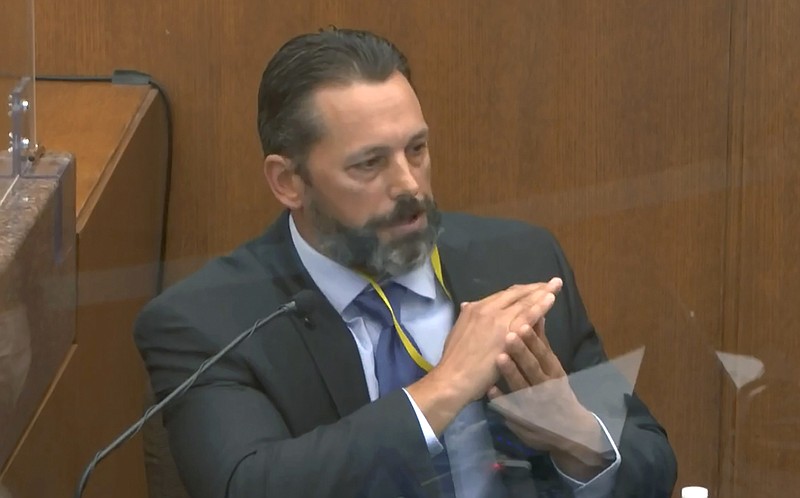MINNEAPOLIS (AP) - Minneapolis police are taught to restrain combative suspects with a knee on their back or shoulders if necessary but are told to "stay away from the neck when possible," a department use-of-force instructor testified Tuesday at former Officer Derek Chauvin's murder trial.
Lt. Johnny Mercil became the latest member of the Minneapolis force to take the stand as part of an effort by prosecutors to dismantle the argument Chauvin was doing what he was trained to do when he put his knee on George Floyd's neck last May.
Several experienced officers, including the police chief himself, have testified Floyd should not have been kept pinned to the pavement by his neck for close to nine and a half minutes by prosecutors' reckoning as the Black man lay face-down, his hands cuffed behind his back.
According to testimony and records submitted Tuesday, Chauvin took a 40-hour course in 2016 on how to recognize people in crisis - including those suffering mental problems or the effects of drug use - and how to use de-escalation techniques to calm them down.
Sgt. Ker Yang, the Minneapolis police official in charge of crisis-intervention training, said officers are taught to "slow things down and re-evaluate and reassess."
Records show Chauvin also underwent training in the use of force in 2018. Mercil said those who attended were taught the sanctity of life is a cornerstone of the department's use-of-force policy and officers must use the least amount of force required to get a suspect to comply.
Under cross-examination by Chauvin attorney Eric Nelson, Mercil testified officers are trained to use their knee across a person's back or shoulder and employ their body weight to maintain control.
But Mercil added: "We tell officers to stay away from the neck when possible."
Nelson has argued the now-fired white officer "did exactly what he had been trained to do over his 19-year career," and he has suggested Floyd's use of illegal drugs and his underlying health conditions are what killed him, not Chauvin's knee.
Nelson sought to point out moments in the video footage when he said Chauvin's knee did not appear to be on Floyd's neck.
Nelson showed Mercil several images taken from officers' body-camera videos, asking after each one whether it showed Chauvin's knee appearing to rest more on Floyd's back, shoulder or shoulder blades than directly on Floyd's neck. Mercil often agreed.
Nelson acknowledged the images were difficult to make out. They were taken at different moments during Floyd's arrest, starting about four minutes after he was first pinned to the ground, according to time stamps on the images.
Chauvin, 45, is charged with murder and manslaughter in Floyd's death May 25. Floyd, 46, was arrested outside a neighborhood market after being accused of trying to pass a counterfeit $20 bill. Floyd, who had taken drugs, frantically struggled with officers who tried to put him in their squad car, saying he was claustrophobic.
Bystander video of Floyd crying he couldn't breathe as onlookers yelled at Chauvin to get off him sparked protests around the U.S. that descended into violence in some cases.
Instead of closing ranks to protect a fellow officer behind what has been dubbed the "blue wall of silence," some of the most experienced members of the Minneapolis force have taken the stand to openly condemn Chauvin's actions.
Chauvin had been certified to perform CPR, and Minneapolis Officer Nicole Mackenzie, who trains members of the force in medical care, testified Tuesday that police department policy required him to start aid before paramedics arrived, if possible.
Officers kept restraining Floyd - with Chauvin kneeling on his neck, another kneeling on Floyd's back and a third holding his feet - until the ambulance got there, even after he became unresponsive, according to testimony and video footage.
The officers also rebuffed offers of help from an off-duty Minneapolis firefighter who wanted to administer aid or tell officers how to do it.
Mercil testified in his experience, it takes less than 10 seconds for someone to be rendered unconscious with a neck restraint. He said someone having a rush of adrenaline or a higher breathing or heart rate can be affected even faster.
Prosecutor Steve Schleicher asked Mercil if any additional body weight on the neck or back would make it more difficult for someone to breathe if the person were handcuffed behind the back and lying face-down. Mercil said yes.
"Have you have ever had a circumstance where an individual has lost their pulse and suddenly come back to life and become more violent?" Schleicher asked, suggesting Floyd was held down long past the point where he might be a threat.
"Not that I'm aware of, sir," Mercil replied.

